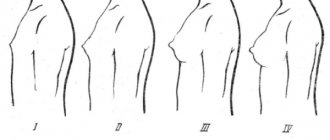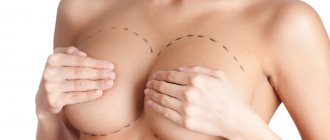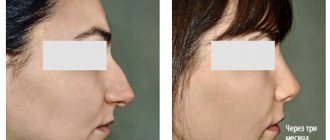Breasts are different - causes of trouble
Before you start looking for a method to solve the asymmetry of the mammary glands, you need to understand why they began to differ in size.
Breasts are noted to be different in women breastfeeding a newborn baby. A difference in the size of the mammary glands occurs when losing or gaining weight.
The growth and formation of a paired breast organ by the age of 17-20 is considered standard, but the bust can change more than once throughout life.
Asymmetry occurs during the years of sexual development, when hormonal changes in the body often provoke the formation of different mammary glands (more often the defect is eliminated on its own).
In adult women, bust deformation occurs due to tissue atrophy and loss of volume.
Lactation contributes to the transformation of the breast due to the unequal filling of the mammary glands with mother's milk. And then the breasts differ in size, and this happens quite often.
However, if the difference is invisible to a prying eye, this is the physiological norm of a particular woman, since it is almost impossible to find mammary glands that are perfectly identical in size (they differ, albeit slightly).
The origin of innate asymmetry
The main reason why breasts are different is a congenital anomaly. Asymmetry often becomes noticeable even at the stage of growth of the mammary glands in a girl. But often by the age of 20, the dissimilarity in size turns out to be barely noticeable.
If minimizing the difference in breast size has not occurred by this age, the problem will not be solved on its own. On the contrary, hormonal changes in the female body (mainly during pregnancy) often lead to an exacerbation of problems in the form of different breasts.
Observing the formation of the bust of a girl who has entered puberty will allow you to avoid an unpleasant situation.
Acquired difference in breast volume (3 reasons)
This trouble is due to several acquired reasons:
- mechanical injury to one of the mammary glands. And then this paired organ stops developing. This happens especially often when playing sports, so you need to be careful;
- asymmetry of the breast due to diseases, for example in the form of a tumor - benign or malignant. Getting rid of them requires surgical intervention if one mammary gland is reduced due to the growth of pathological tissue in it;
- lactation, when milk accumulates unevenly in the right and left breasts and is not consumed equally by the baby from there. During feeding, the child often chooses the same breast, which is due, for example, to a different nipple shape. If there are possible cracks in one nipple, which causes discomfort, the mother prefers to feed the baby with the other breast.
In case of hormonal imbalances or suspicion of a tumor formation, you should immediately consult a doctor.
To rule out oncology, you need to consult a gynecologist or mammologist. After a visual and tactile examination, the doctor may send the patient to undergo an ultrasound. Sometimes a biopsy is also needed.
Plastic surgeon Ralph Garramone
Where does the congenital problem with breast difference come from?
The most common cause of this problem is a congenital anomaly. It can often be seen in teenage girls. However, by the age of twenty, the difference usually evens out.
Otherwise, in order to correct the matter, you will have to take some measures. Otherwise, sooner or later a woman’s hormonal levels will definitely change, which will only worsen the situation.
Anomalies in breast development are often noticeable in teenage girls.
To prevent this, you need to monitor how a girl's breasts develop while she is still a teenager.
Establishing the reason
First, the reason why the breasts are different is established.
- An examination prescribed by a mammologist or gynecologist will allow you to exclude/confirm oncology. The doctor will palpate the condition of the breast and possibly send you for an ultrasound. If serious suspicions arise, a biopsy will be required, after which the doctor will plan treatment.
- If one breast has become larger than the other during lactation, strict adherence to breast hygiene will be required. The baby must be applied to the nipples of the mammary glands alternately from birth. At the same time, make sure that the baby first sucks the milk in full from one breast, and then from the second. And the expressed milk from each breast should also be of equal volume.
- Often a slight discrepancy in breast size is caused by unequal tension in the pectoral muscles. Then, in a “right-hander,” the right arm is loaded more, and the right-sided pectoral muscle works more energetically than the left-sided one and becomes larger. In such a situation, even distribution of the load will help.
After an injury or lactation period, plastic surgery will correct any asymmetry that has not disappeared. It is permissible to enlarge smaller breasts or reduce their volume, or correct the shape of both glands.
If the proportionality of the mammary glands is insignificant, it is possible to visually hide the defect with selected underwear or clothing and accessories.
These are blouses with prints, especially with diagonal stripes, scarves or neckerchiefs, under which the defect is invisible.
An interesting trend noticed by doctors
Experts expressed an opinion worthy of consideration regarding the difference in breast size. It says that those at risk are those representatives of the fair sex who are often in a bad mood or simply stressed. Let's talk in more detail.
Actually, this is quite logical. This is because with constant discontent and neuroses, the risk of stagnation in the liver and gall bladder greatly increases. This affects the muscles of the chest. Consequently, the nutrition of one of the mammary glands suffers. Then, if it continues to grow at all, it is at a much slower pace.
Girls who are often stressed or angry are more susceptible to this problem.
But this is not a reason to despair and give up. You just need to experience more joy and other positive emotions, drawing them, for example, from communicating with loved ones.
Degrees of asymmetry
Patients who contact the clinic are offered various options for correcting breast asymmetry. First, the degree of the defect is established - mild, moderate or severe.
- A mild indicator of breast asymmetry is hardly noticeable, since the mammary glands are almost indistinguishable. The problem is “cured” by choosing the right bra.
- The average degree is characterized by the volume of one mammary gland exceeding the size of the other by 1/3. The flaw is clearly expressed even when wearing the “correct” clothes.
- In severe cases, the difference in volume is 50%, which excessively disturbs the proportions of the body.
The degree of the defect is determined based on the size of the base of the mammary glands and the distance between the nipple and:
- manubrium of the sternum;
- midclavicular line along the border of the gland;
- fold under the mammary gland.
The choice to eliminate violations is based on the asymmetry caused by:
- size and shape of glands;
- position of submammary folds;
- location and/or size of the nipple-areolar complexes;
- a mixture of breast symmetry disorders.
During your consultation, a professional doctor will find out the cause of breast asymmetry and suggest ways to eliminate it.
If you are worried about suspected cancer, go to the doctor. It is better to treat cancer in the early stages.
Plastic surgeon Ralph Garramone
The main options for breast correction are different
Today's medicine provides a variety of methods for correcting different breasts. And women with this problem have the opportunity to get the desired bust shape, eliminating asymmetry.
Therapeutic measures to get rid of breast asymmetry are used for mild pathology.
Vacuum massage activates blood flow, certain physical exercises will strengthen the muscle corset, due to which the mammary glands will be tightened and their shape will slightly improve.
The procedures, although with a temporary effect, still after them the breasts with a slight difference in volume become toned and without obvious signs of asymmetry. Therefore, such techniques are recommended for mandatory use.
In addition, there are such radical methods:
- Endoprosthesis replacement with the use of silicone implants for impaired symmetry of the mammary glands allows you to correct many types of imbalances, in particular tubular breasts. Depending on the state of imbalance, a breast prosthesis is installed on one or two mammary glands at once. The second option will require the use of implants of different volumes.
- Lipofilling involves taking the patient's own fat tissue from certain areas of the body, followed by transplantation of a smaller volume into the breast. The advantages of the procedure are: the hypoallergenic nature of the biomaterial, the impossibility of its rejection in the absence of capsular formation. The disadvantage of lipofilling is that: it is impossible to enlarge the breast by 0.5-1 size larger or take the required amount of adipose tissue for transplantation in patients with low body weight, there is a limited choice of breast shape, the predisposition of the taken biomaterial to resorption (this will cause a decrease in volume paired organ and/or distortion of the model).
- Mastopexy or breast lift performed in vertical, circular, T- or L-shaped and other ways. The procedure primarily eliminates mastoptosis (breast prolapse).
- Reduction mammoplasty helps reduce the volume of one of the mammary glands.
Correction of ptosis is often combined with endoprosthetics or reduction mammoplasty.
There are situations when breasts differ from each other due to unequal sagging. In this case, mastopexy - breast lift - will help.
Plastic surgeon Sheila Nazaryan
Types of asymmetry
There are different classifications of pronounced breast asymmetry:
- hypoplasia – characterized by normal size in one breast and underdeveloped forms in the other;
- underdevelopment of each gland, in this case signs of pronounced asymmetry and sagging breasts appear;
- one gland is of normal size and shape, the other is significantly enlarged;
- a clearly visible change in the size and shape of each breast;
- a pronounced increase in the size of one and a decrease in the other.
- chest deformity.
The interpretation of the classification of these species may differ slightly in other sources, but the variants of pathologies and their similarity remain.
Indications and contraindications
The procedure is indicated for healthy patients after undergoing a full medical examination, including a mammologist.
Correction of asymmetrical breasts using a scalpel is unacceptable in patients who have been diagnosed with health problems caused by the pathologies listed below.
CONTRAINDICATIONS
- diabetes;
- cardiovascular diseases;
- oncological diseases;
- pregnancy and lactation (the period from the end of breastfeeding to surgery on healthy mammary glands is six months).
Before starting the operation, it is necessary to exclude oncology and endocrine diseases. After this, the operation can be performed.
Plastic surgeon Ralph Garramone
Whether it is advisable to perform mammoplasty is decided by a plastic surgeon during a consultation.
If the decision is positive, the surgeon will take anthropometric measurements, select an implant (in case of enlargement of the smallest mammary gland) and specify the location of the endoprosthesis.
Even before the surgical procedure, the patient has the opportunity to see the planned result using computer breast modeling.
The doctor will definitely tell you about possible risks and post-operative unpleasant manifestations. And this is the displacement of the implant, the development of capsular contracture, the appearance of scars, skin necrosis and hyperpigmentation.
In over 90% of surgical interventions performed to eliminate obvious breast asymmetry, a positive result is achieved. The remaining percentage includes operations performed a second time.
How to avoid pathological manifestations
To prevent displacement of the mammary glands after mammoplasty, surgeons recommend following certain rules:
- For one month after the operation, wear compression garments around the clock for 1-1.5 months, which are prohibited from being removed.
- Treat surgical sutures daily with gels and ointments prescribed by the doctor.
- Strictly avoid lifting heavy objects for three weeks.
- It is forbidden to bend sharply, sleep on your stomach, or raise your arms up for 7-10 days.
- During the recovery period, refrain from visiting the bathhouse, pool and beach.
- You should not sunbathe using a solarium (there is a risk of hyperpigmentation of surgical sutures).
- Avoid physical activity and sports.
- At the first symptoms of inflammation of the mammary glands, immediately seek medical advice.
On the third, seventh and tenth days after mammoplasty, you need to come to the doctor for dressings, and subsequently visit a specialist 1-2 times a month until recovery is complete. After 6 months, be sure to do a control ultrasound of the bust.
In addition to the mandatory rules that should be carefully followed, a woman needs to listen to other advice:
- During rehabilitation, to avoid accidental displacement of the implant, carefully control your movements, especially in the arms and upper body.
- During recovery, do not drink alcoholic beverages, which can cause inflammation and other complications in the chest.
- Maintain contact with the surgeon who performed the operation. In the event of an unusual situation and complications, the doctor will advise on further actions.
- The successful performance of mammoplasty depends on the professional experience of the surgeon. therefore, you need to carefully select a specialist for the operation who can correctly select the required size of the prosthesis, taking into account the individual characteristics of the patient’s body.
Question answer
Recovery will take about 2 months, but sometimes the rehabilitation period lasts longer. The results can be fully assessed after 6-12 months.
You need to understand that through exercises the breasts themselves do not pump, the muscles that are located under the mammary glands are pumped up (increased). In this way, you can improve the condition of your breasts and tighten them, but if there is severe asymmetry, exercises will not help.
It depends on the specific situation. If the asymmetry is insignificant, then you can use lipofilling. But if a woman needs extensive correction, then it is better to consider the option of endoprosthetics. In any case, you need to consult a surgeon.
Physical exercise
We must remember that to get the desired result you need to work hard. These exercises do not require special training, but they will help strengthen the muscles of the chest, and in just a couple of months you will have beautiful, high and toned breasts!
- The simplest and most effective way is push-ups. You can do push-ups anywhere and from anything: from the floor, from the sofa, from the bench. If it’s very difficult, you can do push-ups while standing on all fours. For those more experienced, you can perform various variations, such as back-to-bench or one-arm push-ups.
- Exercises with dumbbells: bench press, raises with dumbbells up and to the sides, swings with dumbbells.
Dumbbells can be easily replaced with plastic bottles of water or sand. If for some reason heavy physical activity is contraindicated for you (postoperative or postpartum period), it doesn’t matter!
We use a set of passive exercises:
- Starting position – sitting. Bend your elbows, clasp your palms on your chest facing each other, and squeeze 20 times with force.
- Starting position – sitting. We support our chin with our fists, then spread them to the maximum possible distance and keep our elbows together - three sets of 20 times.
- Starting position – sitting. Bend your arms so that your elbows rest on your sides, actively pressing your forearm to your body – 20 times.
To obtain the desired result, you should constantly increase the number of repetitions. But there are types of asymmetry when surgical intervention is no longer possible.
Different breasts after surgery
There are cases when asymmetry appeared after plastic surgery. This happens due to:
- Swelling. After a major intervention, the formation of edema is considered normal. It may appear unevenly. Therefore, it is worth waiting for a full recovery.
- Surgeon's mistakes. Contact a good doctor to avoid such trouble.
- Unjustified expectations. Sometimes women expect perfect breasts that are completely symmetrical. But that doesn't happen. There will still be differences.
Reviews
ELENA, 22 YEARS OLD:
“The asymmetry after pregnancy was removed using plastic surgery using lipofilling.
At the clinic, excess fat was pumped out from the sides and injected into the breast - before the procedure it was significantly different in size from the other one. I was pleased with the result; it lasted for more than one year. I advise all breastfeeding mothers to properly attach their baby to the breast.
I fed my son with my right breast. He didn’t accept the left one at all. This caused the gland on the right to fill with milk, which cannot be said about the situation on the left.
Although I pumped from her constantly. I noticed a distortion late, when it was impossible to correct it myself. Now my husband and I like breasts.”
ALICE, 25 YEARS OLD:
“It is impossible to do without surgery for different breasts, since the problem will not be resolved on its own. One of my breasts was lower in relation to the other. And with the 1st size of the mammary glands, the imbalance stood out clearly and not aesthetically, although in the before and after photos it is not very noticeable.
Surgery corrected the defect. The plastic surgeon enlarged the breasts to size 3 and removed the asymmetry.
Now the bust looks beautiful. I killed 2 birds with one stone, thanks to a great specialist. Patiently seek your doctor, and then the operation will not seem scary.”
MARIA, 29 YEARS OLD:
“Yes, only surgery can correct unsightly, divergent breasts.
Of course, if there is slight asymmetry, it is worth trying lipofilling. With a more serious problem like mine, I went to the clinic, where the doctor recommended restoring symmetry through endoprosthetics with implants of different volumes.
To make the mammary glands look the same, both had to be enlarged. Now I see that the doctor chose the size of the implants perfectly - he took measurements for a long time.”
Expert opinion
- Surgeon
- Cosmetologist
Elsa Borodina
plastic surgeon
I would like to note that with lipofilling of the mammary glands, about 30% of the transplanted fat survives. That is why it will take about 2-3 procedures to achieve the desired result.
Irina Dorofeeva
practicing cosmetologist
According to statistics, 80% of women have breasts that differ in size, which is often not even noticeable.
But there are situations with obvious asymmetry. Some girls experience poor development of glandular tissue. This condition is called hypoplasia, and the pathology is corrected surgically. But there is a completely different situation when the glandular tissue rapidly grows (macromastia). In this case, the help of a mammologist is needed to determine the cause and prescribe further treatment. Every girl/woman is not alien to aesthetic perfection, and breasts of different sizes do not make her attractive. But when correcting a deficiency, it is important to exclude serious problems with asymmetric mammary glands.











